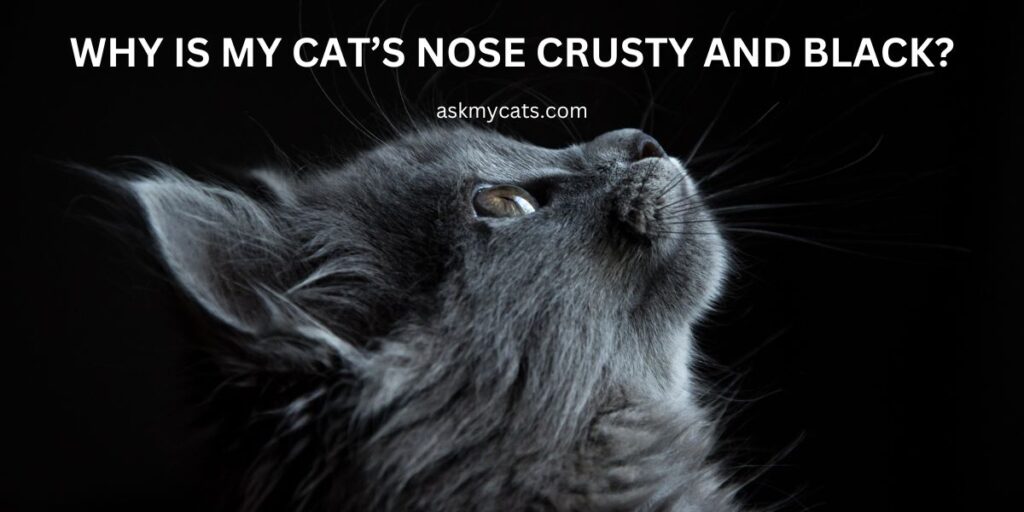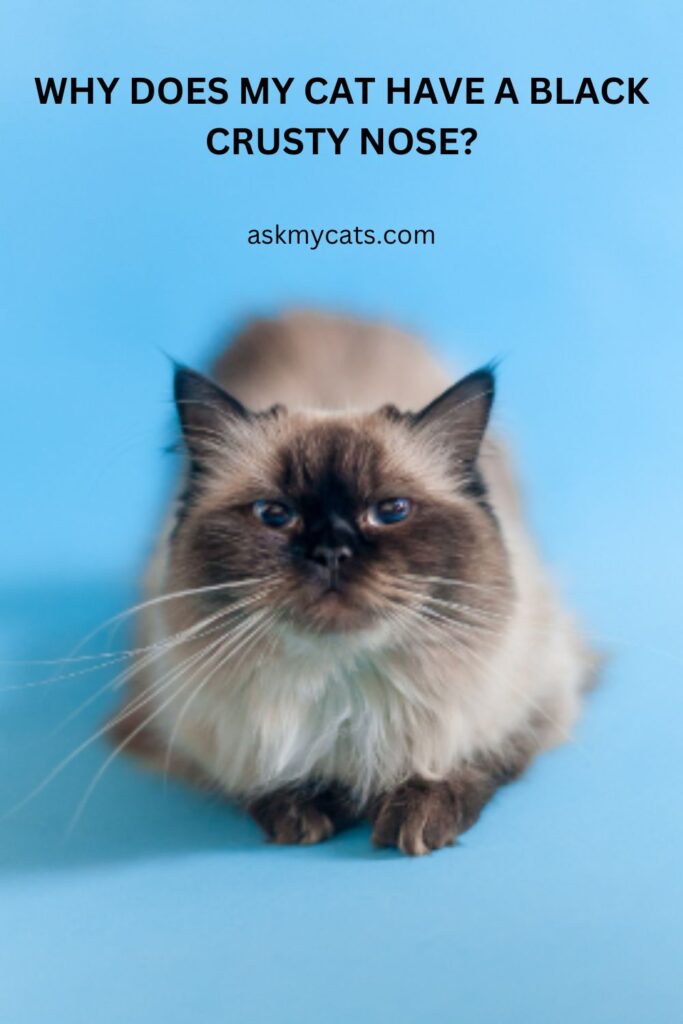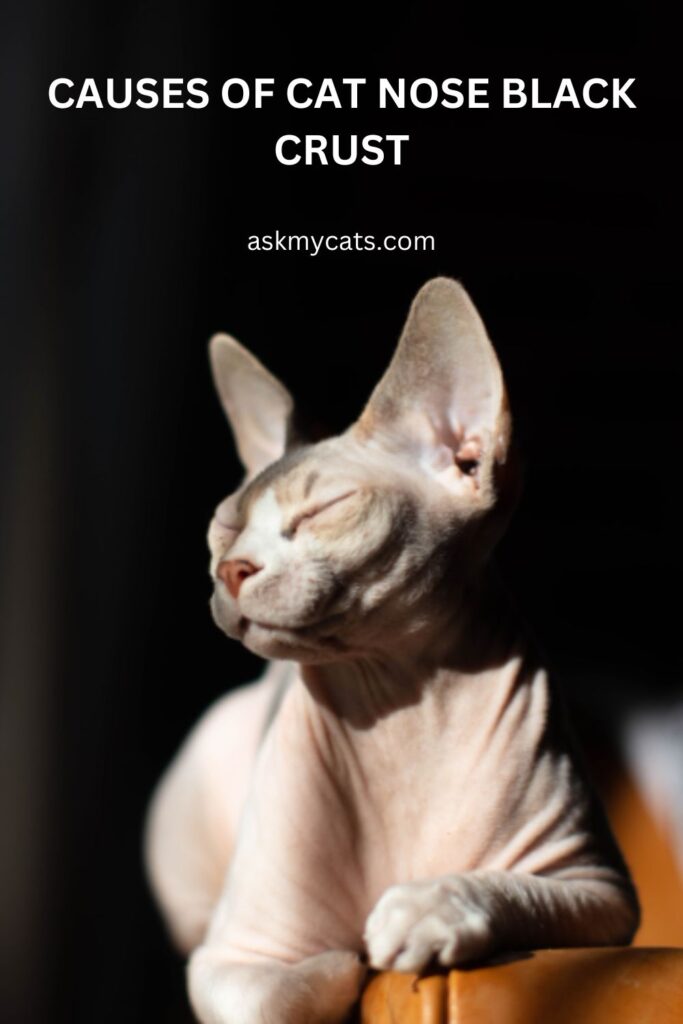Cats are fascinating creatures with unique personalities and quirky habits. As cat owners, we love to observe and analyze their behavior to ensure they are healthy and happy. One area of concern that often arises is the appearance of crusty, black material on a cat’s nose.
While this may seem like a minor issue, it could be a sign of underlying health problems that require attention.
In this article, we’ll explore the possible reasons for your cat’s crusty and black nose, along with tips for identifying and treating the issue.
Key Takeaways
- Cats may develop crusty, black material on their noses, which could indicate underlying health problems.
- Possible causes include dirt and oil build-up, dryness and irritation, or underlying health issues.
- Environmental factors, infections, allergies, trauma, and medical conditions can contribute to black crust formation.
- At-home care involves gently cleansing the nose, using humidifiers, addressing allergies, ensuring proper nutrition, and providing a stress-free environment.
- Seek veterinary care if there are changes in behavior or appetite, spreading or enlarging spots, bleeding or discharge, or persistent spots for more than a week or two.


Give Your Cat the Perfect Day
Get the Free Ebook!
Is It Normal For Cats To Have Black Boogers?
It is not uncommon for cats to develop black boogers, also known as “nasal discharge.” This can happen due to a variety of reasons, some of which are benign and others that may require medical attention.
The black color of the discharge could be caused by dried blood, dirt, or even dust particles that accumulate in the nasal passages.
However, it is important to note that black nasal discharge could also be a symptom of an underlying health issue, such as an infection, allergy, or respiratory problem.
Other signs to look out for include sneezing, coughing, lethargy, loss of appetite, and difficulty breathing.
Why Does My Cat Have A Black Crusty Nose?

While black boogers or crusty black noses are usually harmless, it is better to know what are the potential causes so that you can take timely preventive measures.
There are 3 main reasons why cats may develop a black, crusty nose.
1 – Dirt and oil build-up
One possibility is that your cat’s nose is simply dirty and the black crust is a build-up of dirt and oil. Cats use their noses to explore their environment and their noses can become dirty just like our hands or feet can.
2 – Dryness and irritation
Another possibility is that your cat’s nose has become dry and irritated, leading to the development of black, crusty material. This can happen if your cat is spending time in a dry environment or if they have an underlying health issue that is affecting its skin.
3 – Underlying health issues
Lastly, a black crust on a cat’s nose can be a sign of an underlying health issue such as an infection, inflammation, or even skin cancer.
If you notice other concerning symptoms such as sneezing, coughing, or lethargy, it’s important to take your cat to a veterinarian for a proper diagnosis and treatment plan.
Interesting Read: Why Is There A Black Spot On My Cat’s Nose?
Causes Of Cat Nose Black Crust

The causes of black crust on a cat’s nose can vary and may include:
Environmental Factors
- Exposure to dust, dirt, or other debris in the air
- Living in a dry environment
- Irritants such as smoke, chemicals, or perfumes
Infections
- Bacterial, viral, or fungal infections can cause inflammation and crust formation
- Feline herpesvirus, calicivirus, and chlamydia are common culprits
Allergies
- Allergic reactions to food, pollen, or other environmental factors can cause nasal inflammation and discharge
- Contact allergies to plastics, fabrics, or cleaning agents can also be a trigger
Trauma
- Injuries to the nose or face can cause bleeding and scabbing, leading to the formation of black crust
Medical Conditions
- Autoimmune diseases, such as pemphigus, can cause skin lesions and crust formation
- Tumors, both benign and malignant, can affect the nose and cause scabbing and bleeding
Interesting Read: Why Is My Cat’s Nose Turning Black?
At-Home Care For Cats With Crusty Black Spots

If your cat has crusty black spots on their nose, there are some at-home care measures you can take to help alleviate their symptoms:
- Gently Cleanse the Nose
Using a soft cloth or cotton pad, gently wipe away any visible crust on your cat’s nose. Use a saline solution to clean the nose, which can help loosen any dried mucus. Avoid using harsh chemicals or perfumes as they may irritate the skin
- Use Humidifiers
Dry air can cause nasal dryness and irritation. Place a humidifier in the room where your cat spends the most time to help keep the air moist.
- Address Underlying Allergies
If your cat has allergies that are causing the crusty black spots on its nose, try to identify and remove the trigger. Work with your veterinarian to determine if antihistamines or other medications can help alleviate symptoms.
- Ensure Proper Nutrition
A balanced diet can help boost your cat’s immune system, which can aid in fighting infections and inflammation.
- Provide a Stress-Free Environment
Stress can weaken your cat’s immune system and make them more susceptible to illnesses. Provide plenty of hiding places and toys, and try to minimize changes in routine.
Interesting Read: Why Do Cat Noses Change Color?
Potential Complications Of Crusty Black Spots On A Cat’s Nose
If crusty black spots are left untreated on a cat’s nose, there are potential complications that could arise. These may include:
- Nasal discharge, caused by infection or allergies, which could lead to blockages in the nasal passages and difficulties in breathing.
- Pain and discomfort from untreated black spots which could lead to further irritation and discomfort.
- Secondary infections may arise from underlying infections that may spread to other parts of the body and cause more serious health issues.
- Skin cancer, though a rare case, may also be a cause for the black spots on a cat’s nose. If untreated, cancer may spread to other parts of the body and become life-threatening.
Prevention Of A Crusty Black Nose In Cats
Cat owners can take several measures to reduce the risk of their cats developing a crusty black noses. These include regular grooming to prevent the accumulation of dirt and debris on their nose, which could lead to irritation and inflammation.
Feeding them a balanced and healthy diet can boost their immune system, making it easier for their bodies to fight off infections and inflammation.
Modifications to the environment are also necessary to minimize allergic reactions in cats. Owners should keep their homes clean and free from dust while using a humidifier during dry weather conditions to prevent nasal dryness and irritation.
Additionally, reducing stress can help prevent illnesses by strengthening the cat’s immune system. Providing hiding places and toys and avoiding changes in routine can help reduce stress levels.
Regular veterinary check-ups can also help identify and address potential health issues before they become serious.
While preventing a crusty black nose in cats may not always be possible, these measures can help reduce the risk and improve the overall health and well-being of cats.
Interesting Read: Why Does Your Cat Have a White Nose?
When To Seek Veterinary Care For Crusty Black Spots On A Cat’s Nose
If you notice crusty black spots on your cat’s nose, it is important to monitor them closely and seek veterinary care if any of the following occur:
Changes in behavior or appetite
- If your cat shows signs of lethargy, loss of appetite, or other behavioral changes, it may be an indication of an underlying health problem that needs medical attention
The spots spread or become larger
- If the crusty black spots on your cat’s nose spread to other areas or become larger, it could be a sign of infection or cancer
Bleeding or discharge
- If the spots on your cat’s nose start to bleed or produce discharge, it could be a sign of infection or injury that needs medical attention
The spots persist for more than a week or two
- If the crusty black spots on your cat’s nose persist for more than a week or two, it may be a sign of an underlying health problem that needs medical attention
Frequently Asked Questions
What causes crusty black spots on a cat’s nose?
There are several potential causes, including infections, allergies, nasal dermatitis, and skin cancer.
Can I treat crusty black spots on my cat’s nose at home?
It is best to seek veterinary care for any changes in your cat’s health, including crusty black spots on its nose. However, some at-home remedies, such as cleaning the affected area or using a humidifier, may help relieve symptoms.
How can I prevent my cat from developing crusty black spots on its nose?
Regular grooming, proper nutrition, environmental modifications, minimizing stress, and regular veterinary check-ups can help reduce the risk of your cat developing a crusty black nose.
Final Words
Crusty black spots on a cat’s nose can be a sign of an underlying health problem and should be monitored closely.
Seeking veterinary care if you notice any concerning symptoms can help identify the underlying cause and prevent any potential complications.
Additionally, taking preventative measures, such as proper grooming and nutrition, can help reduce the risk of your cat developing this condition.
